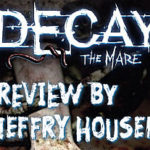Decay: The Mare – Review
If you like horror stories and adventure games, then give this a shot. A budget version of Scratches, which isn’t all bad.
Genre: Point-And-Click Adventure / Horror
Release date: February 13, 2015
What is more important to an adventure game? Is it the puzzles that provide the challenge and interactivity? Or is it the story that draws you in and paints a rich canvas on top of the pixelated world? I was recently involved in a discussion about this, and overwhelmingly, people chose story over puzzles. I said I prefer puzzles. Everyone agreed the best games have a balance between the two, where puzzles drive the story somehow.
The first game I played following this discussion was Decay: The Mare, an episodic point-and-click horror adventure game, and I think it was built to challenge my assertion that puzzles are my favorite part of an adventure game.
The game’s opening has very little in the way of explanations, and you are almost immediately dropped into the game. The tutorial section shows you how to use the controls and how to take your nightly drugs. You play a character in a mental institution who’s started having weird dreams. The game’s promotional materials provide a greater story setup than there is in Episode 1.
The bulk of the game consists of exploring the mental institution, sometimes through dreams and sometimes through reality. However, I was never really sure which was which. Puzzles consist of finding keys to open doors, collecting items and using them together. Each episode had at least one puzzle that I solved by brute force – by trying all options until something worked. That may mean either the hints weren’t obvious enough in the game, or that brute force was indeed the intended solution. Either way, it points to poor game design.
The game plays like a clone of the original Myst. Each room is made up of multiple static screens, and you switch between them by clicking buttons on the left, right, or bottom of the screen. This makes navigation confusing, as every time you enter a room you start from the same vantage point. The game does not identify the door through which one enters. So, when I was backtracking through rooms I already visited, I would often end up going in circles because I’d choose the wrong door through which to leave. I guess I was spoiled by the Dungeons from the original Ultima trilogy which were able to take into account your point of entry when drawing a room, despite having a much simpler design.
The graphic quality is modern and acceptable, but in today’s world it may have benefited from more animation or some type of 3D environment to simulate movement. The sound helps boost the atmosphere and the game has its fair share of jump scares. The voice acting is solid, although most of the time you won’t have anyone to talk to.
The game comes with a built-in hint system; however, it’s pretty useless. Either it directs you to a certain location or tells you that you have to search the room more. It does not give any specific information on what you need to do. Sometimes the hint icon disappears from the interface, but I was never quite sure why.
The true story behind the game doesn’t reveal itself until the endgame, which is the third episode. The story leaves even more questions than answers, however, and makes me question a lot of what had come before. In Episode 1 I was confused and frustrated. I liked Episode 2, but by Episode 3, I was just ready for the game to end. If you like horror stories and adventure games, then give this a shot. I’d describe Decay: The Mare as a budget version of Scratches, which isn’t all bad.
|
+ Creepy Atmosphere, with the occasional jump scare
– At times this felt like a hidden object game more than a compelling adventure
– Episode quality varies
– You don’t find the true story until the end of Episode 3
|

|
Processor: 2.2 GHz Dual Core
Memory: 2 GB RAM
Graphics: NVIDIA GeForce 205, Radeon HD 3400
Hard Drive: 2.1 GB available space
Processor: MacBook, MacBook Air, MacBook Pro, Mac Mini, iMac or Mac Pro release year 2009 or later
Memory: 4 GB RAM
Graphics: NVIDIA GeForce 9400M, Radeon HD 3450

Leave a Reply